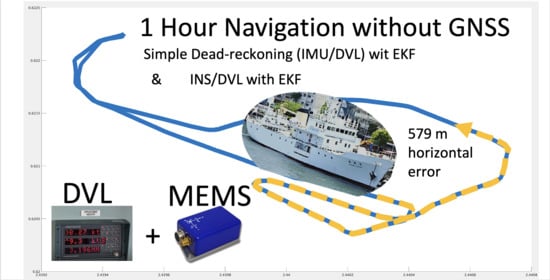Performance Evaluation of IMU and DVL Integration in Marine Navigation
Abstract
1. Introduction
2. Method 1—Dead-Reckoning Navigation Using IMU and DVL
2.1. Direction Estimation
2.1.1. Direction Estimation by IMU with GNSS Using KF
- : GNSS direction [°]
- : Gyroscope angular velocity with bias taken into account as shown in Equation (14) [°/s]
- dir: Indicates that dir is a calculation of direction.
- = 0.2 [s]…GNSS frequency;
- …GNSS error standard deviation of orientation;
- …IMU error standard deviation of angular velocity.
- : State vectors
- : State − space matrix
- : Covariance matrix
- : Number of updates of KF for direction estimation
2.1.2. Direction Estimation Using Only IMU
2.2. Velocity Estimation
2.2.1. Velocity Observation by GNSS
2.2.2. Velocity Observation with DVL
- : Sonar speed in X axis [m/s]
- : Sonar speed in Y axis [m/s]
2.2.3. Speed Estimation by KF
- = 1 [s]…DVL observation period
- = 0.11 [m/s]…DVL speed error Standard deviation in X direction
- = 0.11 [m/s]…DVL speed error Standard deviation in Y direction
- = 0.06 [m/s2]…IMU acceleration error standard deviation in X direction
- = 0.06 [m/s2]…IMU acceleration error standard deviation in Y direction
- : Number of updates of KF for velocity estimation
2.3. Position Estimation
3. Method 2—INS/DVL Integrated Navigation
3.1. Parameter Estimation by Allan Variance
3.2. INS/DVL Integration
4. Experiment and Results
4.1. Experiment Outline
4.2. Results with First Method
4.2.1. Evaluation of Estimated Direction
4.2.2. Evaluation of Speed Estimation
4.2.3. Position Estimation Result
4.3. Results with Second Method
4.3.1. Evaluation of Estimated Attitude
4.3.2. Evaluation of Speed Estimation
4.3.3. Evaluation of Position Estimation
5. Discussion
6. Conclusions
Author Contributions
Funding
Institutional Review Board Statement
Informed Consent Statement
Data Availability Statement
Acknowledgments
Conflicts of Interest
References
- Chang, L.; Niu, X.; Liu, T. GNSS/IMU/ODO/LiDAR-SLAM Integrated Navigation System Using IMU/ODO Pre-Integration. Sensors 2020, 20, 4702. [Google Scholar] [CrossRef] [PubMed]
- Nguyen, T.D. Determining Safety Limitations and the Frequency of Determining Vessel Location When Establishing Marine Bases on the Vietnam’s Sea Areas. J. Phys. Conf. Ser. 2020, 1515. [Google Scholar] [CrossRef]
- Larsen, M.B. High Performance Doppler-Inertial Navigation-Experimental Results. In Proceedings of the OCEANS 2000 MTS/IEEE Conference and Exhibition, Cat No. 00CH37158, Providence, RI, USA, 11–14 September 2000; Volume 1442, pp. 1449–1456. [Google Scholar]
- Rogne, R.H.; Bryne, T.H.; Fossen, T.I.; Johansen, T.A. On the Usage of Low-Cost MEMS Sensors, Strapdown Inertial Navigation, and Nonlinear Estimation Techniques in Dynamic Positioning. IEEE J. Ocean. Eng. 2020, 46, 24–39. [Google Scholar] [CrossRef]
- Rogne, R.H.; Bryne, T.H.; Fossen, T.I.; Johansen, T.A. MEMS-Based Inertial Navigation on Dynamically Positioned Ships: Dead Reckoning. IFAC-PapersOnLine 2016, 49, 139–146. [Google Scholar] [CrossRef]
- Li, W.; Zhang, L.; Sun, F.; Yang, L.; Chen, M.; Li, Y. Alignment Calibration of IMU and Doppler Sensors for Precision INS/DVL Integrated Navigation. Optik 2015, 126, 3872–3876. [Google Scholar] [CrossRef]
- Nagin, I.A.; Inchagov, Y.M. Effective Integration Algorithm for Pedestrian Dead Reckoning. In Proceedings of the 2018 Moscow Workshop on Electronic and Networking Technologies (MWENT), Moscow, Russia, 14–16 March 2018; pp. 1–4. [Google Scholar]
- Núñez, J.M.; Araújo, M.G.; García-Tuñón, I. Real-Time Telemetry System for Monitoring Motion of Ships Based on Inertial Sensors. Sensors 2017, 17, 948. [Google Scholar] [CrossRef] [PubMed]
- Ben, Y.; Huang, L.; Yang, X. A Rapid Damping Method for a Marine Strapdown INS. Ocean Eng. 2016, 114, 259–268. [Google Scholar] [CrossRef]
- Moussa, M.; Moussa, A.; Elhabiby, M.; El-Sheimy, N. Investigation of Different Low-Cost Land Vehicle Navigation Systems Based on Cpd Sensors and Vehicle Information. ISPRS Ann. Photogramm. Remote Sens. Spat. Inf. Sci. 2020, V-1-2020, 189–197. [Google Scholar] [CrossRef]
- Silson, P.M.G. Coarse Alignment of a Ship’s Strapdown Inertial Attitude Reference System Using Velocity Loci. IEEE Trans. Instrum. Meas. 2011, 60, 1930–1941. [Google Scholar] [CrossRef]
- Gonzalez, R.; Dabove, P. Performance Assessment of an Ultra Low-Cost Inertial Measurement Unit for Ground Vehicle Navigation. Sensors 2019, 19, 3865. [Google Scholar] [CrossRef]
- Bryne, T.H.; Rogne, R.H.; Fossen, T.I.; Johansen, T.A. A Virtual Vertical Reference Concept for Aided Inertial Navigation at the Sea Surface. Control Eng. Pract. 2018, 70, 1–14. [Google Scholar] [CrossRef]
- Podobnik, J.; Kraljić, D.; Zadravec, M.; Munih, M. Centre of Pressure Estimation during Walking Using Only Inertial-Measurement Units and End-to-End Statistical Modelling. Sensors 2020, 20, 6136. [Google Scholar] [CrossRef] [PubMed]
- Romanovas, M.; Ziebold, R.; Lança, L. A Method for IMU/GNSS/Doppler Velocity Log Integration in Marine Applications. In Proceedings of the 2015 International Association of Institutes of Navigation World Congress (IAIN), Prague, Czech Republic, 20–23 October 2015; pp. 1–8. [Google Scholar]
- Kamolov, A.; Park, S. An IoT-Based Ship Berthing Method Using a Set of Ultrasonic Sensors. Sensors 2019, 19, 5181. [Google Scholar] [CrossRef] [PubMed]
- Federal Aviation Administration and United States. Pilot’s Handbook of Aeronautical Knowledge; Skyhorse Publishing, Inc.: New York, NY, USA, 2009.
- González, R.; Giribet, J.I.; Patiño, H.D. An Approach to Benchmarking of Loosely Coupled Low-Cost Navigation Systems. Math. Comput. Model. Dyn. Syst. 2015, 21, 272–287. [Google Scholar] [CrossRef]
- Gonzalez, R.; Catania, C.; Dabove, P. NaveGo: An Open-Source MATLAB/GNU Octave Toolbox for Processing Integrated Navigation Systems and Performing Inertial Sensors Profileing Analysis, Version 1.2. 2019. Available online: https:github.com/rodralez/NaveGo (accessed on 20 January 2021).
- Gonzalez, R.; Giribet, J.I.; Patino, H.D. NaveGo: A Simulation Framework for Low-Cost Integrated Navigation Systems. Control Eng. Appl. Inform. 2015, 17, 110–120. [Google Scholar]
- Savage, P.G. Strapdown Analytics, 2nd ed.; Part 2; Strapdown Associates, Inc.: Maple Plain, MN, USA, 2007. [Google Scholar]
- MATLAB. Complementaryfilter. Available online: https://jp.mathworks.com/help/fusion/ref/complementaryfilter-system-object.html (accessed on 23 December 2020).
- Savage, P. Strapdown Inertial Navigation Lecture Notes; Strapdown Associates Inc.: Maple Plain, MN, USA, 2010. [Google Scholar]
- Savage, P.G. Strapdown Analytics, 2nd ed.; Part 1; Strapdown Associates, Inc.: Maple Plain, MN, USA, 2007. [Google Scholar]
- Titterton, D.; Weston, J.L.; Weston, J. Strapdown Inertial Navigation Technology; IET: London, UK, 2004; Volume 17. [Google Scholar]
- Brown, R.G.; Hwang, P.Y. Introduction to Random Signals and Applied Kalman Filtering; John Wiley & Sons, Inc.: New York, NY, USA, 1992. [Google Scholar]
- Groves, P.D. Principles of GNSS, Inertial, and Multisensor Integrated Navigation Systems, 2nd ed.; Artech House on Demand: Norwood, MA, USA, 2013. [Google Scholar]
- Japan Aviation Electronics Industry, Ltd. JCS7402-A Specification. Available online: https://www.jae.com/files/user/doc/JCS7402-A.pdf (accessed on 23 December 2020).
- iXblue. Phins Surface. Available online: https://www.ixblue.com/sites/default/files/2020-11/Phins_DS%20%281%29.pdf (accessed on 23 December 2020).
- A.953(23)REVOKED World—Wide Radionavigation System. Available online: https://puc.overheid.nl/nsi/doc/PUC_1419_14/1/ (accessed on 20 January 2021).
- Terry MChris HAndy NChris HDavid, P.; Nick, W. The Potential Impact of GNSS/INS Integration on Maritime Navigation; Cambridge University Press: Cambridge, UK, 2008. [Google Scholar]
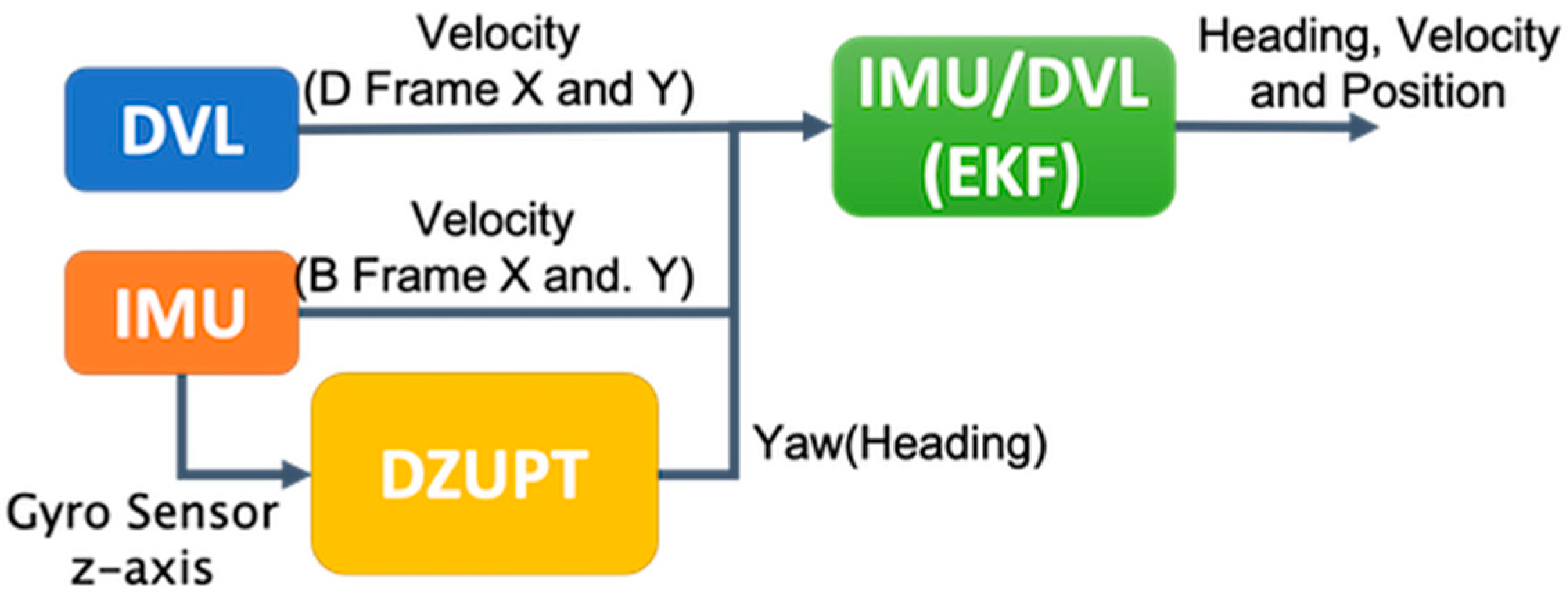
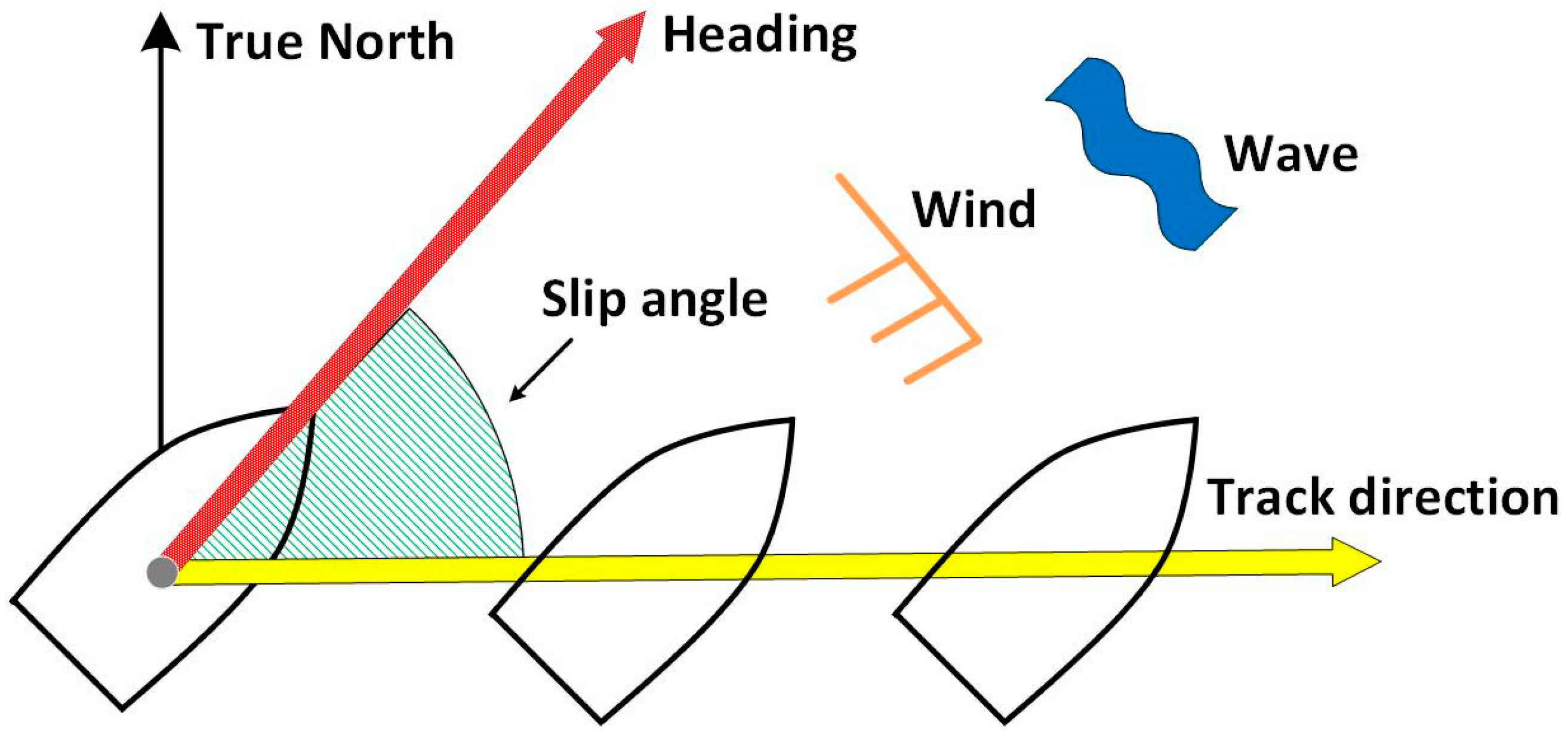

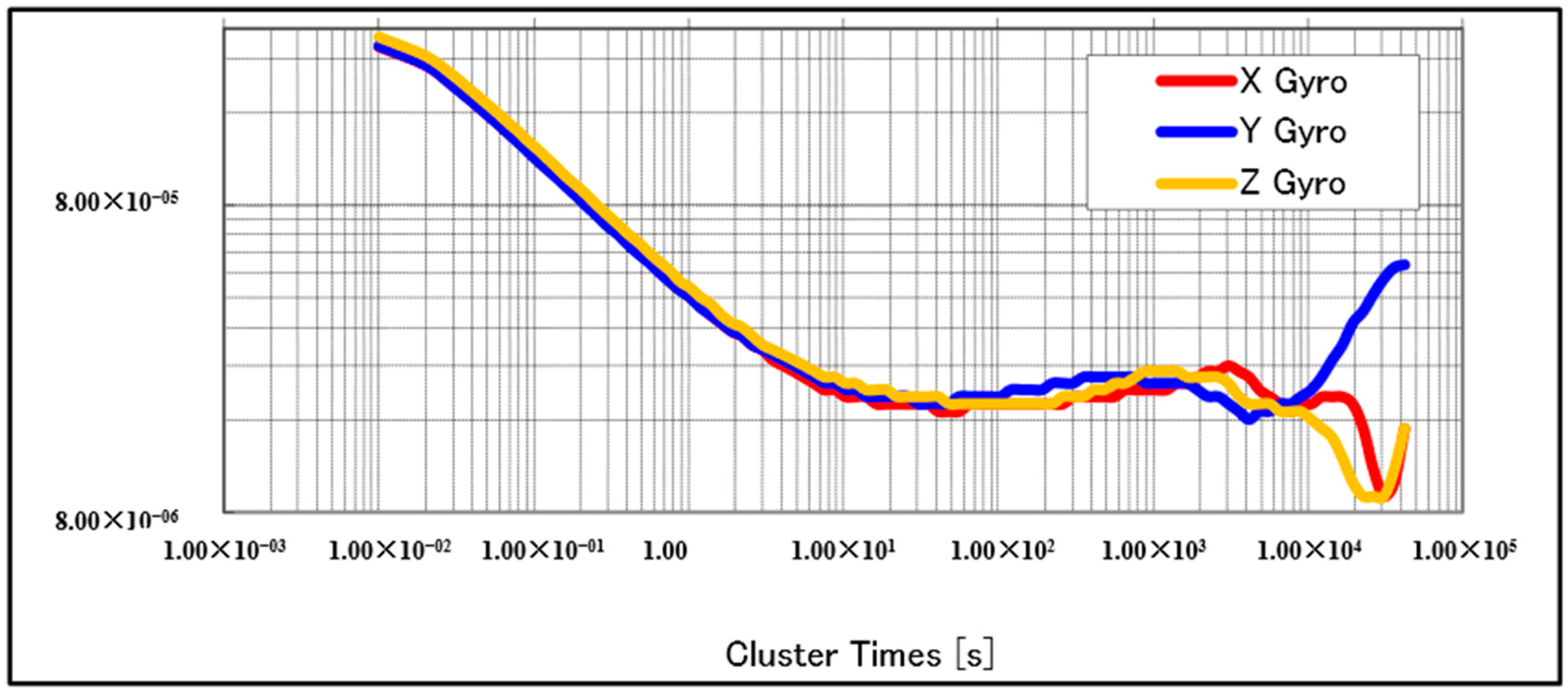
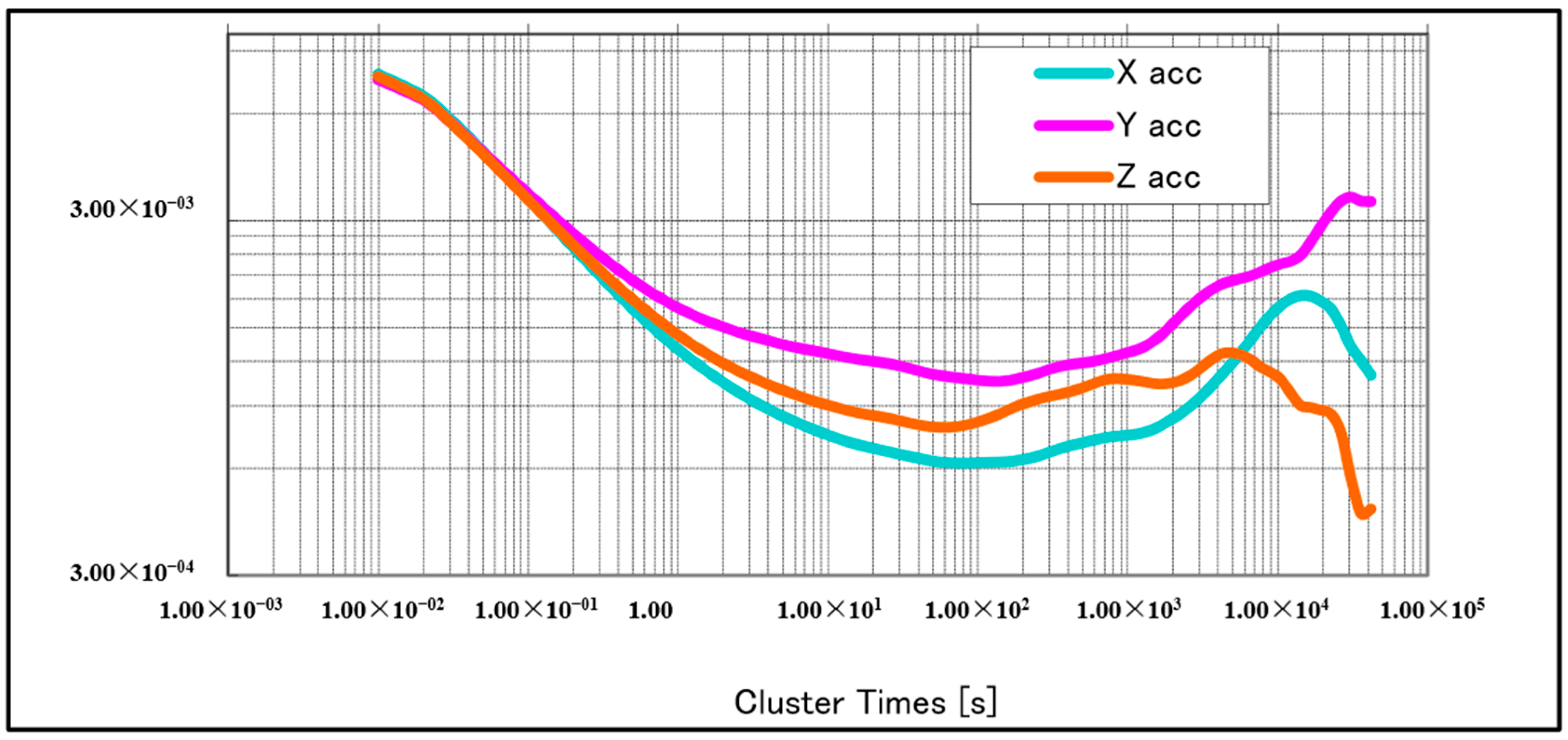
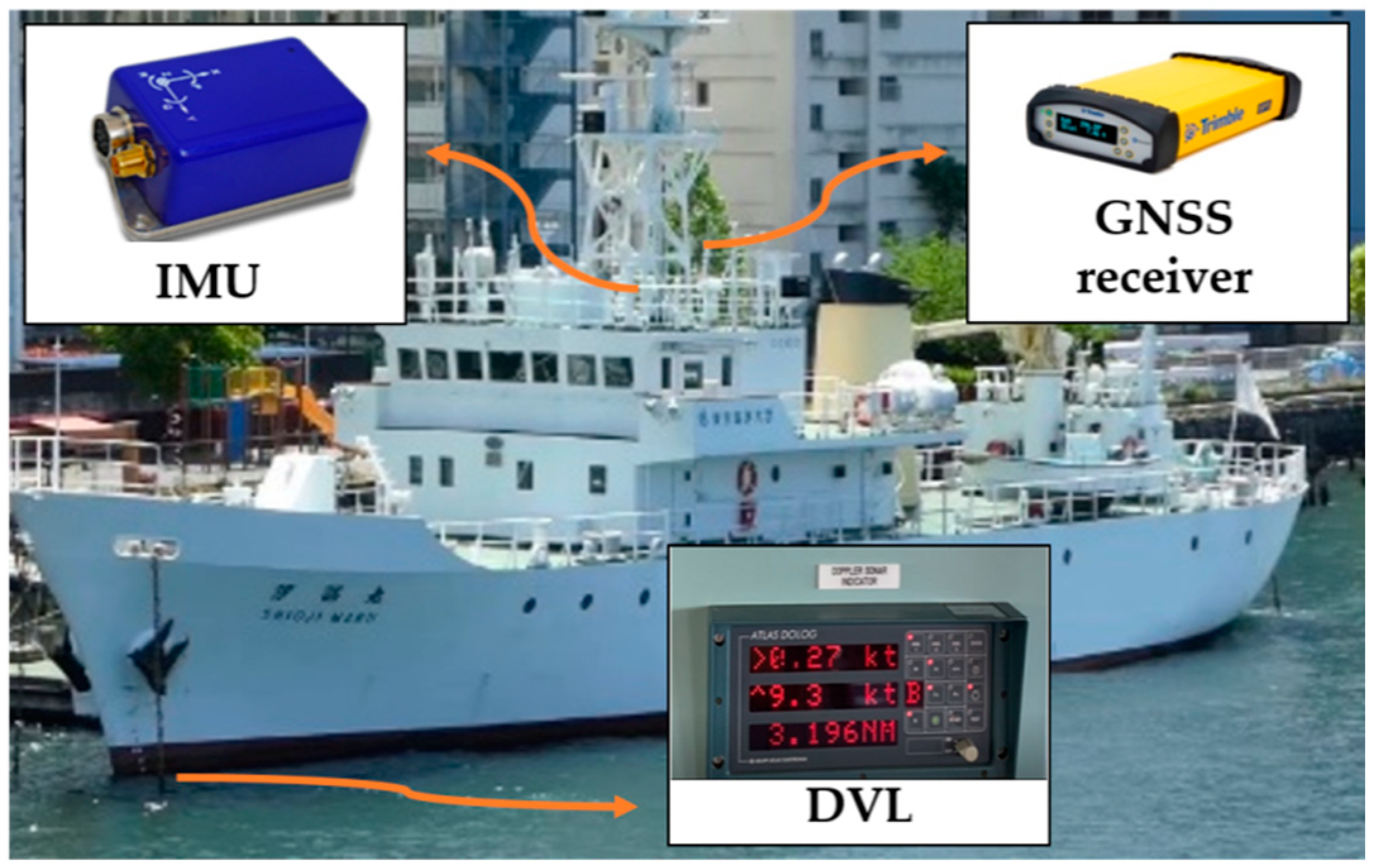

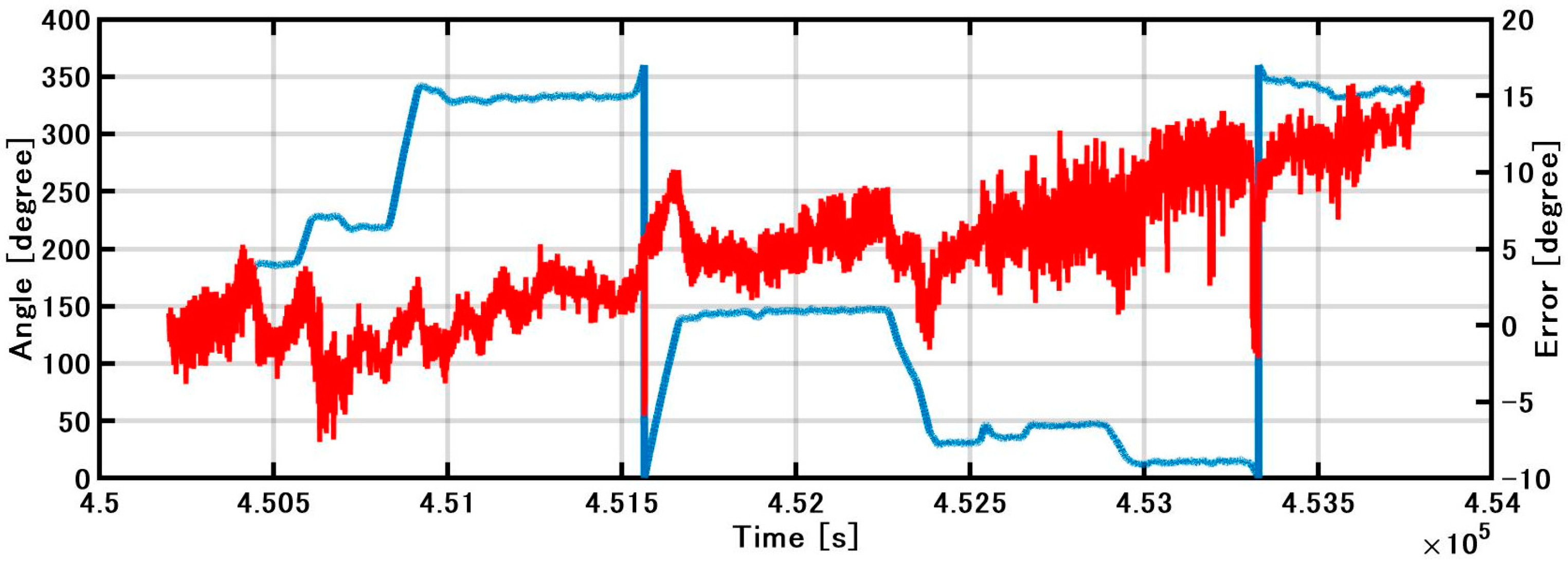

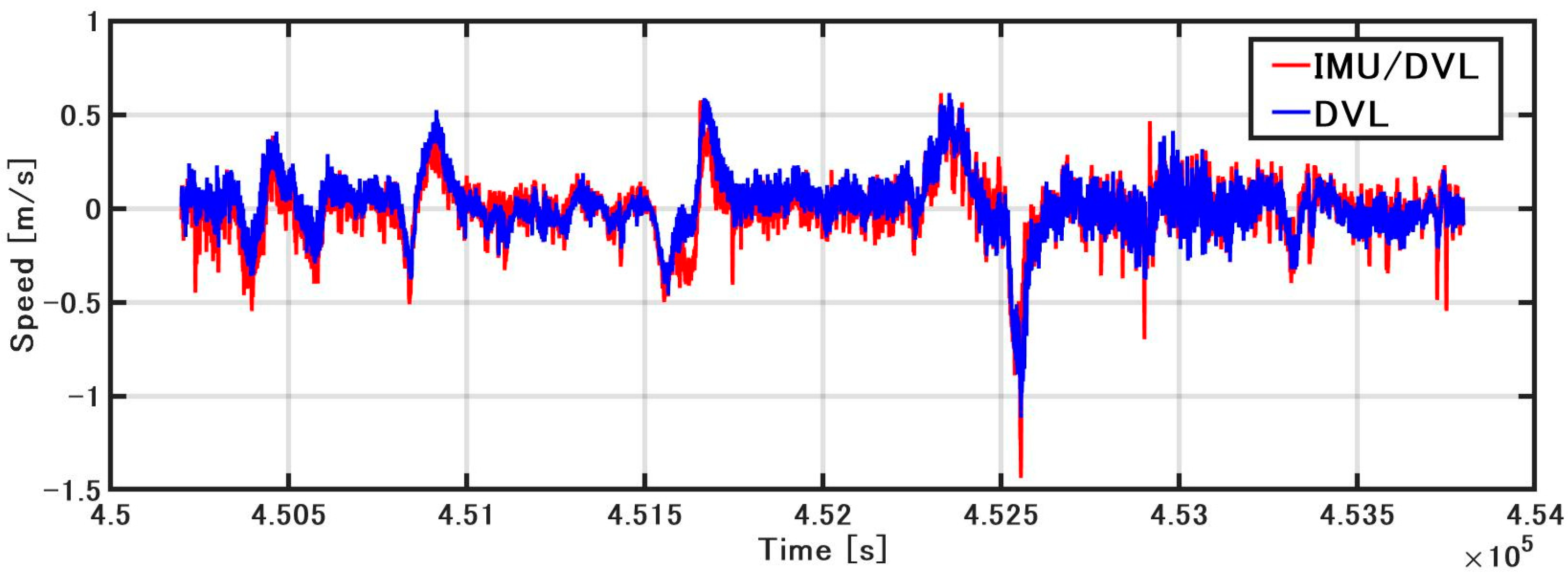
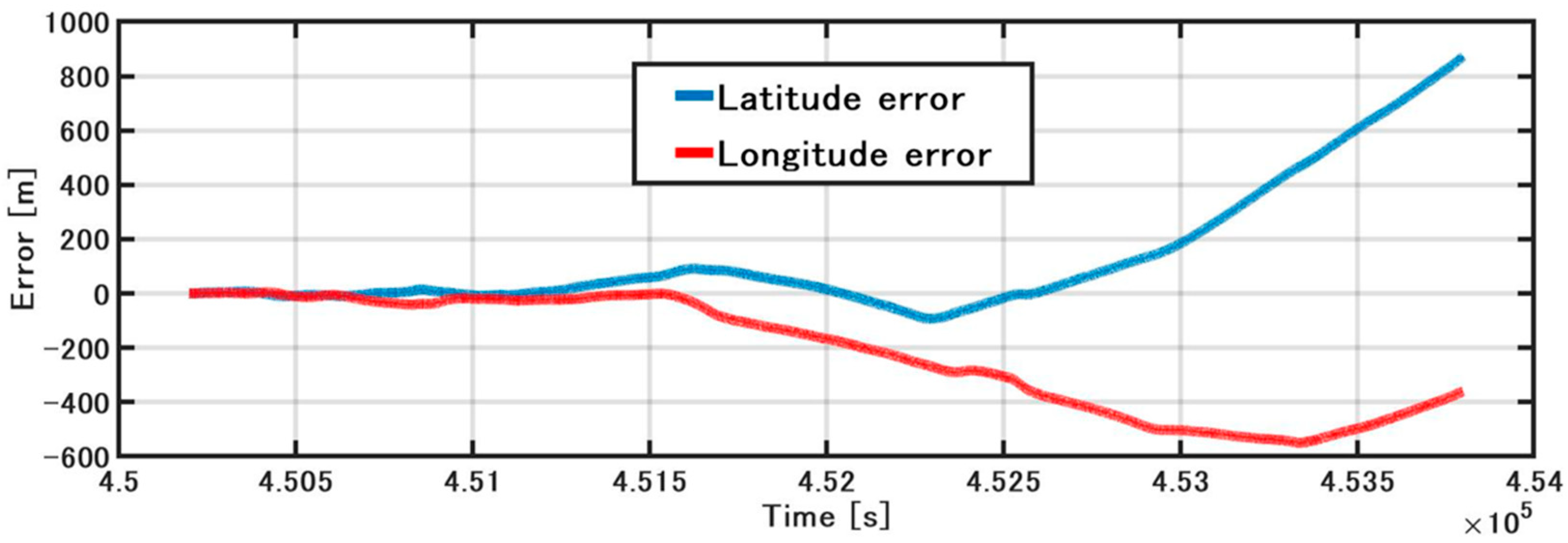
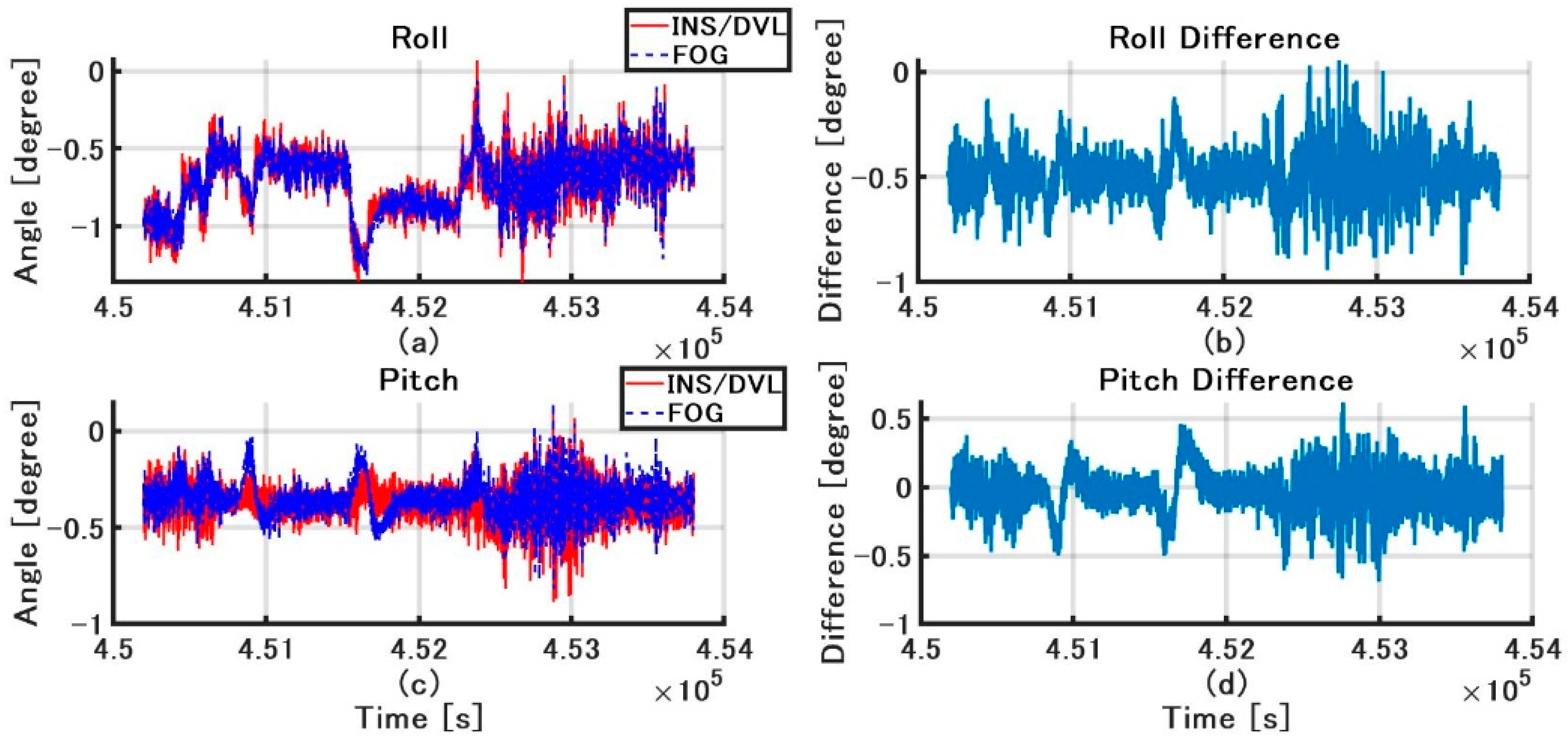
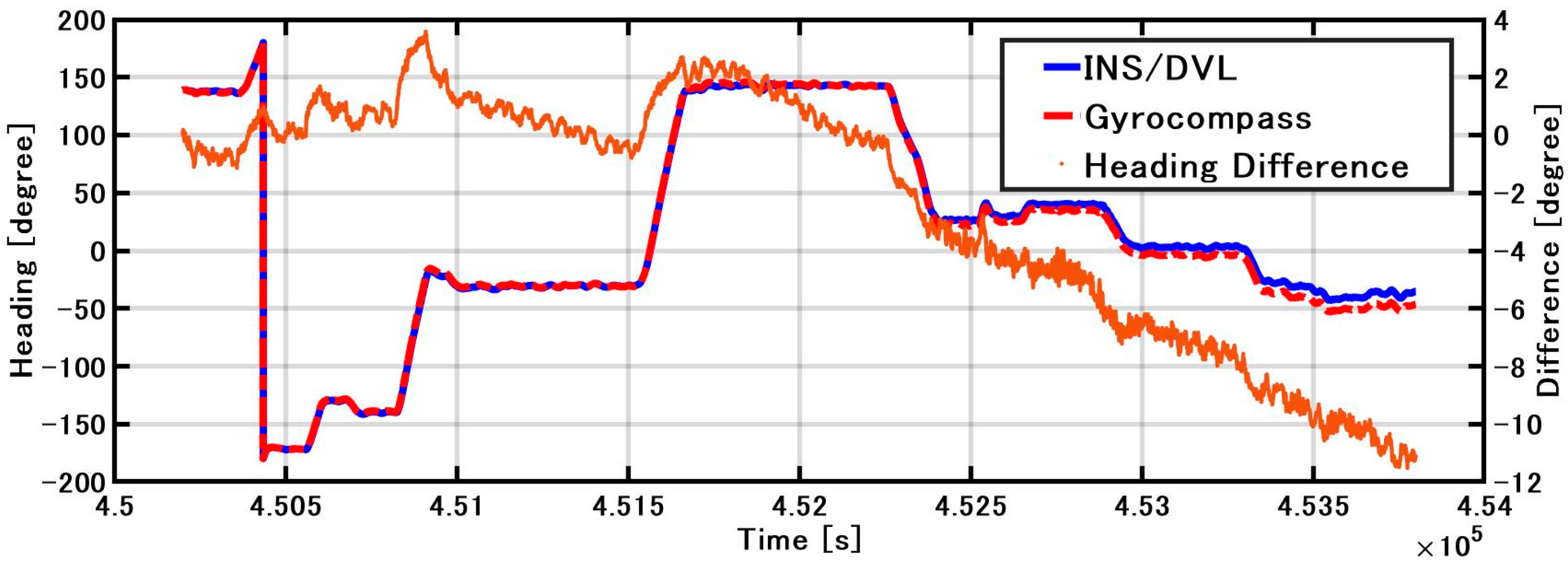

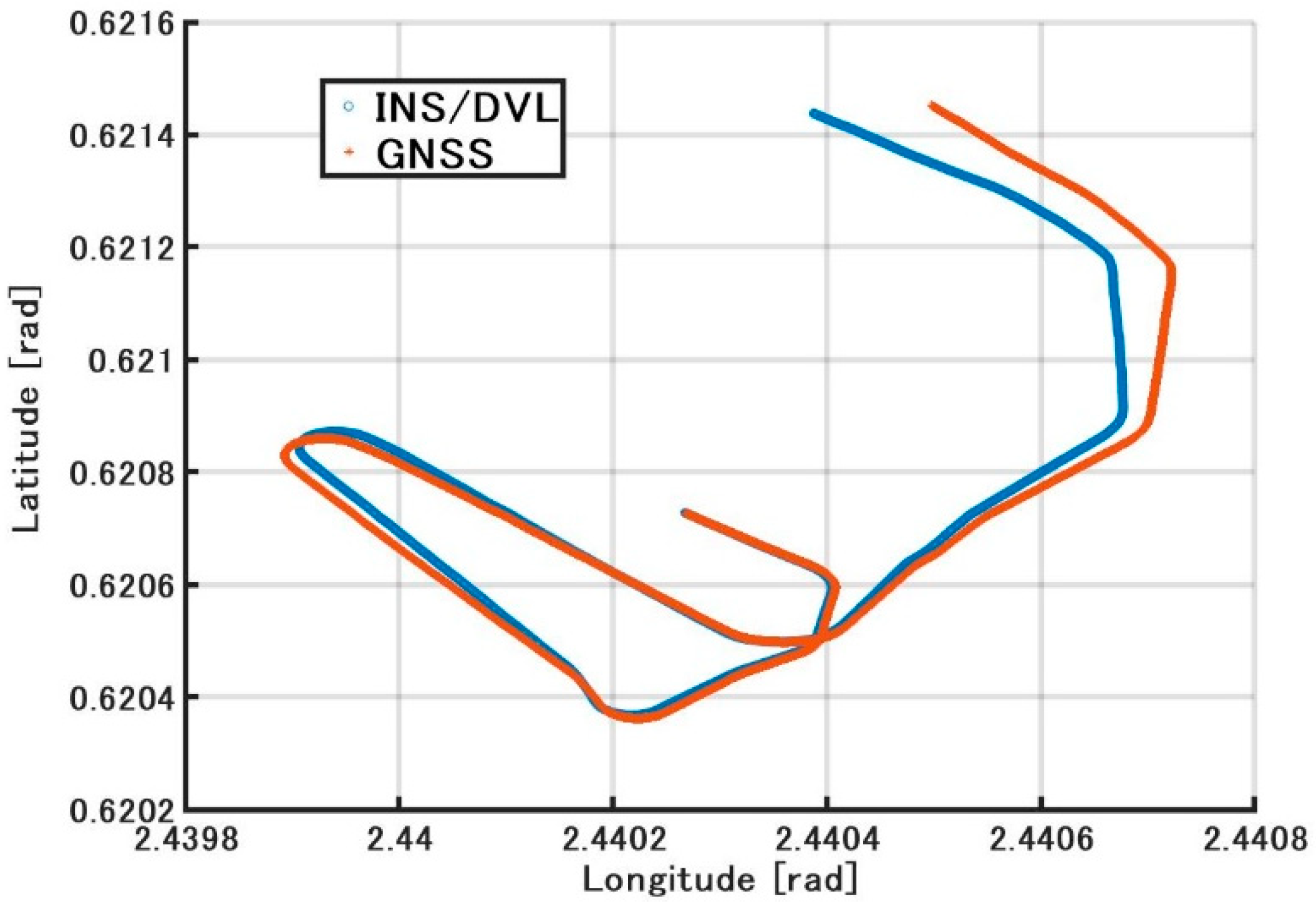

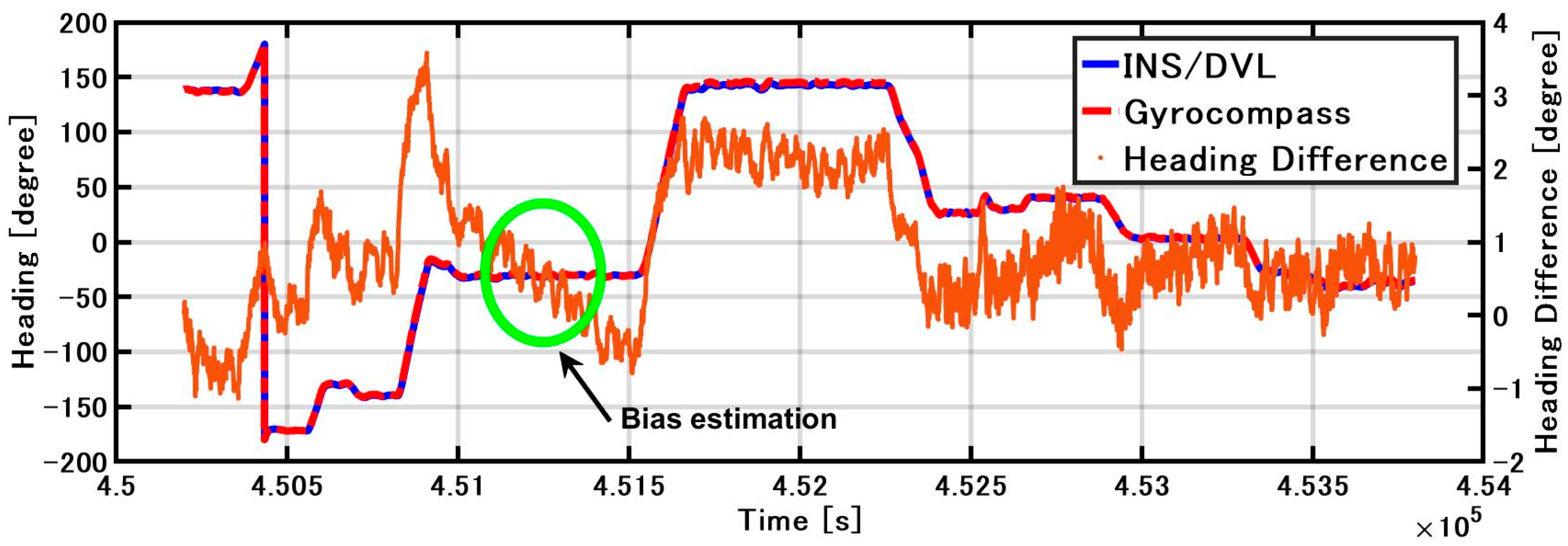

| Static Bias (rad/s) (m/s2) | STD (rad/s) (m/s2) | Random Walk | Bias Instability (rad/s) (m/s2) | |
|---|---|---|---|---|
| Gyro X | −7.825 × 10−04 | 3.088 × 10−04 | 4.00 × 10−05 | 2.63 × 10−05 |
| Gyro Y | 3.234 × 10−03 | 3.107 × 10−04 | 4.00 × 10−05 | 2.90 × 10−05 |
| Gyro Z | 2.202 × 10−03 | 3.307 × 10−04 | 4.30 × 10−05 | 2.67 × 10−05 |
| Acc X | 6.389 × 10−02 | 9.326 × 10−03 | 1.29 × 10−03 | 9.35 × 10−04 |
| Acc Y | 5.178 × 10−01 | 1.005 × 10−02 | 1.69 × 10−03 | 1.59 × 10−03 |
| Acc Z | −9.940 | 9.255 × 10−03 | 1.40 × 10−03 | 1.20 × 10−03 |
| X-Axis | Y-Axis | Z-Axis | |
|---|---|---|---|
| 2.63 × 10−5 [rad/s] | 2.90 × 10−5 [rad/s] | 2.67 × 10−5 [rad/s] | |
| 9.34 × 10−4 [m/s2] | 1.60 × 10−03 [m/s2] | 1.20 × 10−3 [m/s2] | |
| 0.966 × 10−7 [rad] (Equation (14.81) of [27]) | |||
| 0.101 × 10−3 [m/s] (Equation (14.81) of [27]) | |||
| 0.115 × 10−10 [rad] | 0.115 × 10−10 [rad] | 0.115 × 10−10 [rad] | |
| 0.435 × 10−7 [m/s] | 0.261 × 10−7 [m/s] | 0.435 × 10−7 [m/s] | |
| 60 [s] | 60 [s] | 60 [s] | |
| 60 [s] | 100 [s] | 60 [s] | |
| 1.0 [s] | |||
| GNSS | IMU | DVL | ||
|---|---|---|---|---|
| Name | Trimble SPS855 | CSM-MG100 | ATLAS DOLOG SYSTEM | |
| Frequency | 5 Hz | 100 Hz | 1 Hz | |
| Accuracy | Position | Gyro | Acceleration | Speed |
| <0.1 [m] | ±0.01 [m/s2] | ±0.00175 [rad/s] | 0.01 [knot] or 0.2% of the measured value | |
| Setting Time | Within 2 h | Accuracy on Scorsby Table | Less than ±0.5° |
| Setting Point Error | Less than ±0.3° | Repeatability of Setting Point | Less than ±0.2° |
| RMS Value | Less than 0.1° | Accuracy Under Environmental Variation | Less than ±0.5° |
| Digital Output | |
|---|---|
| Range | ±Roll: ±180°, Pitch: ±90° |
| Resolution | <0.1° |
| Accuracy | <±0.15° at input <±10° <± (0.2° + 1% of input) at input = ±10°~45° |
Publisher’s Note: MDPI stays neutral with regard to jurisdictional claims in published maps and institutional affiliations. |
© 2021 by the authors. Licensee MDPI, Basel, Switzerland. This article is an open access article distributed under the terms and conditions of the Creative Commons Attribution (CC BY) license (http://creativecommons.org/licenses/by/4.0/).
Share and Cite
Fukuda, G.; Hatta, D.; Guo, X.; Kubo, N. Performance Evaluation of IMU and DVL Integration in Marine Navigation. Sensors 2021, 21, 1056. https://doi.org/10.3390/s21041056
Fukuda G, Hatta D, Guo X, Kubo N. Performance Evaluation of IMU and DVL Integration in Marine Navigation. Sensors. 2021; 21(4):1056. https://doi.org/10.3390/s21041056
Chicago/Turabian StyleFukuda, Gen, Daisuke Hatta, Xiaoliang Guo, and Nobuaki Kubo. 2021. "Performance Evaluation of IMU and DVL Integration in Marine Navigation" Sensors 21, no. 4: 1056. https://doi.org/10.3390/s21041056
APA StyleFukuda, G., Hatta, D., Guo, X., & Kubo, N. (2021). Performance Evaluation of IMU and DVL Integration in Marine Navigation. Sensors, 21(4), 1056. https://doi.org/10.3390/s21041056








